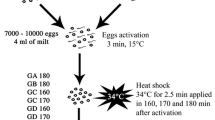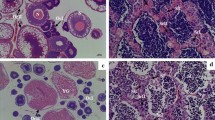Abstract
In the present study, methodology of gynogenetic induction in spotted halibut were developed and optimized; the sex ratio of putative meiotic gynogenetic diploids was determined using AFLP-based molecular sexing technique; the homozygosity of gynogenetic population was assessed as opposed to cultivated population. The results showed that high percentage of meiotic gynogenetic diploids were generated when the eggs fertilized with irradiated heterologous sea perch frozen sperm (30–50 mJ cm−2) were cold shocked in sea water of −1°C for 40–75 min at 5 min after fertilization. About 15,200 diploid gynogenetic larvae were achieved and they exhibited normal morphology similar to diploid control. The gynogenetic diploids were 100% female, which first confirmed the female homogamete (XX/XY) sex determination in spotted halibut. The genetic analysis showed that the average H O was, respectively, 0.404 and 0.724 in gynogenetic population and cultivated population, indicating an increase of homozygosity in gynogenetic population.


Similar content being viewed by others
References
Baroiller JF, D’Cotta H, Saillant E (2009) Environmental effects on fish sex determination and differentiation. Sex Dev 3:118–135
Bruford MW, Wayne RK (1993) Microsatellites and their application to population genetic studies. Curr Opin Genet Dev 3:939–943
Cal RM, Vidal S, Martínez P et al (2006) Growth and gonadal development of gynogenetic diploid Scophthalmus maximus. J Fish Biol 68:401–413
Chakraborty BK, Miah MI, Mirja MJA et al (2006) Induction of gynogenesis in endangered sarpunti, Puntius sarana (Hamilton) and evidence for female homogamety. Aquaculture 258:312–320
Chen SL, Li J, Deng SP, Tian YS et al (2007) Isolation of female-specific AFLP markers and molecular identification of genetic sex in half-smooth tongue sole (Cynoglossus semilaevis). Mar Biotechnol 9:273–280
Chen SL, Deng SP, Ma HY et al (2008) Molecular marker-assisted sex control in half-smooth tongue sole (Cynoglossus semilaevis). Aquaculture 283:7–12
Chen SL, Tian YS, Yang JF et al (2009) Artificial gynogenesis and sex determination in the half-smooth tongue sole (Cynoglossus semilaevis). Mar Biotechnol 11:243–251
Felip A, Zanuy S, Carrillo M et al (2001) Induction of triploidy and gynogenesis in teleost fish with emphasis on marine species. Genetica 111:175–195
Flynn SR, Matsuoka M, Reith M et al (2006) Gynogenesis and sex determination in shortnose sturgeon, Acipenser brevirostrum Lesuere. Aquaculture 253:721–727
Fopp-Bayat D, Kolman R, Woznicki P (2007) Induction of meiotic gynogenesis in sterlet (Acipenser ruthenus) using UV-irradiated bester sperm. Aquaculture 264:54–58
Francescon A, Barbaro A, Bertotto D et al (2005) Assessment of homozygosity and fertility in meiotic gynogens of the European sea bass (Dicentrarchus labrax L.). Aquaculture 243:93–102
Fujioka Y (1998) Survival, growth and sex ratios of gynogenetic diploid honmoroko. J Fish Biol 52:430–442
Griffiths R, Orr KL, Adam A et al (2000) DNA sex identification in the three-spined stickleback. J Fish Biol 57:1331–1334
Ji XS, Chen SL, Tian YS et al (2004) Cryopreservation of sea perch (Lateolabrax japonicus) spermatozoa and feasibility for production-scale fertilization. Aquaculture 241:517–528
Komen H, Thorgaard GH (2007) Androgenesis, gynogenesis and the production of clones in fishes: a review. Aquaculture 269:150–173
Li Y, Cai M, Wang Z et al (2008) Microsatellite-centromere mapping in large yellow croaker (Pseudosciaena crocea) using gynogenetic diploid families. Mar Biotechnol 10:83–90
Liu ZJ, Cordes JF (2004) DNA marker technologies and their applications in aquaculture genetics. Aquaculture 238:1–37
Ma HY, Chen SL (2009) Isolation and characterization of 31 polymorphic microsatellite markers in barfin flounder (Verasper moseri) and the cross-species amplification in spotted halibut (Verasper variegatus). Conserv Genet 10:1591–1595
Ma HY, Bi JZ, Shao CW et al (2009a) Development of 40 microsatellite markers in spotted halibut (Verasper variegatus) and the cross-species amplification in barfin flounder (Verasper moseri). Anim Genet 40:576–578
Ma HY, Chen SL, Ji XS et al (2009b) Isolation and characterization of female-specific AFLP markers in spotted halibut (Verasper variegatus). Environ Biol Fish (Accepted)
Miao GD, Shao CW, Liao XL et al (2009) Development of polymorphic microsatellite markers from barfin flounder (Verasper moseri) and their cross-species amplification. Conserv Genet 10:701–703
Mori T, Saito S, Kishioka C et al (2004) Induction of triploids and gynogenetic diploids in barfin flounder Verasper moseri. Nippon Suisan Gakkaishi 70:145–151
Nagy A, Rajki K, Horvárth L et al (1978) Investigation on carp, Cyprinus carpio L. gynogenesis. J Fish Biol 13:215–224
Nomura K, Morishima K, Tanaka H et al (2006) Microsatellite-centromere mapping in the Japanese eel (Anguilla japonica) by half-tetrad analysis using induced triploid families. Aquaculture 257:53–67
Ortega-Villaizan Romo M, Nakajima M et al (2003) Isolation and characterization of microsatellite DNA markers in the rare species barfin flounder (Verasper moseri) and its closely related species spotted halibut (V. variegatus). Mol Ecol Notes 3:629–631
Piferrer F, Cal RM, Gómez C et al (2004) Induction of gynogenesis in the turbot (Scophthalmus maximus): effects of UV irradiation on sperm motility, the Hertwig effect and viability during the first 6 months of age. Aquaculture 238:403–419
Purdom CE, Thompson D, Dando PR (1976) Genetic analysis of enzyme polymorphisms in plaice (Pleuronectes platessa). Heredity 37:193–206
Reid DP, Smith CA, Rommens M et al (2007) A genetic linkage map of Atlantic halibut (Hippoglossus hippoglossus L.). Genetics 177:1193–1205
Rice WR (1989) Analyzing tables of statistical tests. Evolution 43:223–225
Rougeot C, Ngingo JV, Gillet L et al (2005) Gynogenesis induction and sex determination in the Eurasian perch, Perca fluviatilis. Aquaculture 243:411–415
Sekino M, Saitoh K, Aritaki M (2008) Microsatellite markers for a rare species of right-eye flounder Verasper variegatus (Pleuronectiformes, Pleuronectidae). Conserv Genet 9:761–765
Tautz D, Renz M (1984) Simple sequences are ubiquitous repetitive components of eukaryotic genomes. Nucleic Acids Res 12:4127–4138
Tian YS, Chen SL, Ji XS et al (2008) Cryopreservation of spotted halibut (Verasper variegatus) sperm. Aquaculture 284:268–271
Tvedt HB, Benfey TJ, Martin-Robichaud DJ et al (2006) Gynogenesis and sex determination in Atlantic halibut (Hippoglossus hippoglossus). Aquaculture 252:573–583
Váradi L, Benkó I, Varga J et al (1999) Induction of diploid gynogenesis using interspecific sperm and production of tetraploids in African catfish, Clarias gariepinus Burchell (1822). Aquaculture 173:401–411
Wada T, Aritaki M, Tanaka M (2004) Effects of low-salinity on the growth and development of spotted halibut Verasper variegatus in the larva-juvenile transformation period with reference to pituitary prolactin and gill chloride cells responses. J Exp Mar Biol Ecol 308:113–126
Wang J, Liu H, Min W et al (2006) Induced meiotic gynogenesis in tench, Tinca tinca (L.) using irradiated heterogenic sperm. Aquac Int 14:35–42
Xu JH, You F, Sun W et al (2008) Induction of diploid gynogenesis in turbot Scophthalmus maximus with left-eyed flounder Paralichthys olivaceus sperm. Aquac Int 16:623–634
Yamazaki F (1983) Sex control and manipulation in fish. Aquaculture 33:329–354
You C, Yu X, Tan D et al (2008) Gynogenesis and sex determination in large-scale loach Paramisgurnus dabryanus (Sauvage). Aquac Int 16:203–214
Zheng K, Lin KD, Liu ZH et al (2007) Comparative microsatellite analysis of grass carp genomes of two gynogenetic groups and the Xiangjiang river group. J Genet Genomics 34:321–330
Zhu XC, Liu HJ, Sun XW et al (2006) Assessment of homozygosity in gynogenetic diploid using microsatellite markers in Japanese flounder (Paralichthys olivaceus). Zool Res 27:63–67 (In Chinese with English abstract)
Acknowledgments
We would like to express our thanks to Mr. Liu Shoutang in Haiyang fisheries Co., Ltd. for providing spotted halibut eggs and experimental fish. This work was supported by grants from State 863 High-Technology R&D Project of China (2006AA10A403), Shandong Genetic Improvement Key Project for Agricultural Organism, and Taishan Scholar Project of Shandong Province.
Author information
Authors and Affiliations
Corresponding author
Rights and permissions
About this article
Cite this article
Ji, XS., Chen, SL., Yang, JF. et al. Artificial gynogenesis and assessment of homozygosity in meiotic gynogens of spotted halibut (Verasper variegatus). Aquacult Int 18, 1151–1161 (2010). https://doi.org/10.1007/s10499-010-9330-y
Received:
Accepted:
Published:
Issue Date:
DOI: https://doi.org/10.1007/s10499-010-9330-y




